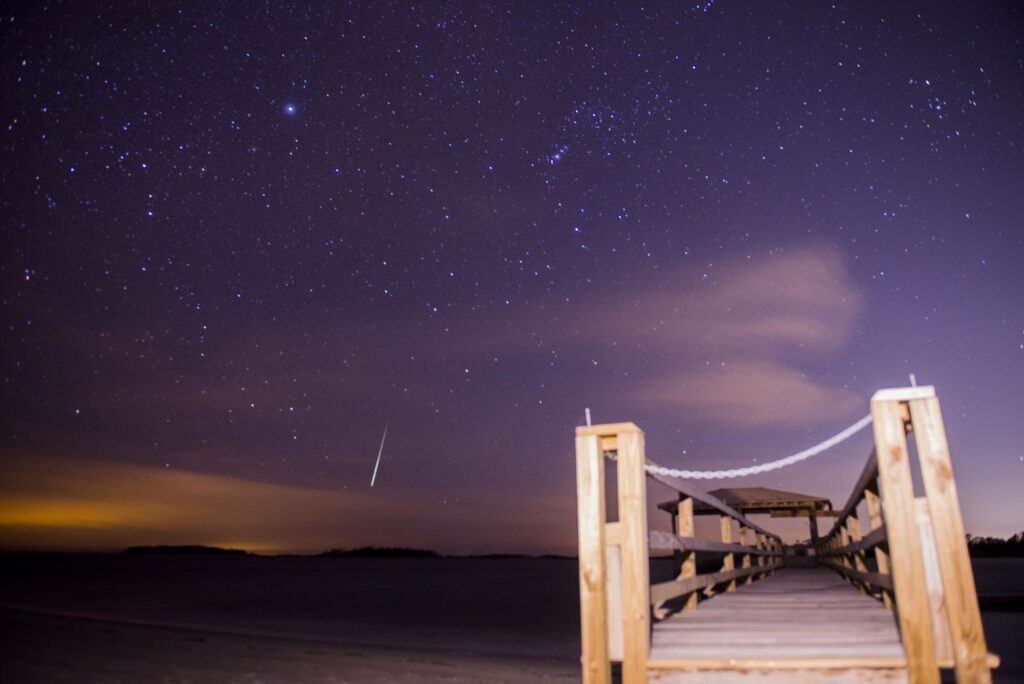You’ve got a few more days to catch the Geminid meteor shower

The Geminid meteor shower lights up the night sky above Tybee Island, Ga., early Thursday, Dec. 14, 2017. The year’s best meteor shower, the Geminids, peaks this week, with lucky stargazers seeing as many as one or even two a minute in the darkest spots. The meteors will reach their frenzy Thursday, Dec. 14, 2023. (Will Peebles/Savannah Morning News via AP, File)
If you missed the peak of the Geminid meteor shower on Wednesday, Dec. 13 into the morning of Thursday, Dec. 14, don’t fret. The event actually lasts until Dec. 17, so there’s still a chance to see blazing trails of light across the sky as meteor showers burst in the darkness.
Meteor showers are usually best viewed when the sky is darkest, after midnight but before sunrise, says Dennis Mammana, an astronomy author and lecturer.
He explains why it happens.
“It occurs because the Earth orbits the sun and, every year around this time, it encounters a swarm of dusty particles scattered around the orbit of the asteroid Phaethon,” Mammana says in his blog.
“When we on Earth slam into this debris, we see the particles fall into the upper atmosphere and burn up. You may know these as falling stars or shooting stars.”
Mammana says there are many misconceptions about meteor showers, so he answers some common questions.
Question: How many meteorites will I see?
Answer: None. What you will see will be meteors. When a particle is out in space, we know it as a “meteoroid.” When it falls into the Earth’s atmosphere and burns up, we call it a “meteor.” Only if it’s a large enough rock to survive its plunge through the air and crash to the ground is it called a “meteorite.”
Q: Why couldn’t I see anything when I stepped outside for a few minutes to check the sky?
A: Your eyes need at least a half-hour to adjust to the darkness before you can expect to see most meteors, and you must spend more than a few minutes keeping watch.
Q: I read that “the sky would light up with meteors,” so why could I only see a few?
A: Don’t be taken in when the media (print, electronic and especially social media) blow celestial phenomena out of proportion. The Geminids can produce around 120 meteors per hour under ideal circumstances (that’s perhaps two per minute on average). The key word here is “average” over the entire night. It also depends on how dark your sky is, how dark adapted your eyes are and where in the heavens you look.
Q: OK, so where should I look?
A: Up. No, I’m not being flip, that’s the answer. Folks who gaze only toward Gemini, for example — the point in the sky from which these meteors appear to radiate — see very few. Those who lie back on a lawn chair and take in the entire sky will see the most.
Q: Why do astronomers always suggest viewing after midnight?
A: Because that’s our best chance to see meteors. In the evening hours, we’re looking into space out the planet’s “back window.” By dawn, however, the Earth has rotated enough that we’re peering in the direction we’re moving. And much like driving through a rain or snowstorm, it’s always the front window that gets pelted the most.
Before you get out there in the cold to enjoy the year’s best meteor shower, here are some skywatching tips from NASA.


